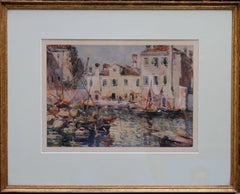Joshua Anderson Hague
19th Century Impressionist Landscape Drawings and Watercolors
Watercolor
Frederick William Jackson for sale on 1stDibs
Frederick William Jackson, or simply known as Fred Jackson, was liked and respected in his day, praised as an artist and renowned for his landscape and marine paintings. It was generally felt that he could have achieved the distinction of RA had it not been for his reticence and modesty. Jackson was born in 1859 in Middleton Junction, Oldham, and was one of three children, whose father was a photographer. His two brothers were Vincent Jackson, a musician trained at Leipzig Conservatoire, and Charles Arthur Jackson, an art dealer and Manchester gallery owner. Charles supported his brother during his career, helping with both money and materials. Many of Jackson's pictures bear labels inscribed with the address of his brother's gallery, 7 Police Street, Manchester.
Jackson had relatively little formal training, however, his interest in painting was evident from an early age. As a boy he went on sketching tours with his friend, the future architect, Edgar Wood. After leaving school, he attended evening classes at Oldham School of Art, where he studied painting under John Houghton Hague. John Hague's brother, Joshua Anderson Hague, was the leader of a group of young artists known as the 'Manchester School.' This group was making a considerable impact in the mid-1870s and Jackson was drawn towards them. Nearly all these artists had been trained at Manchester Academy of Fine Art and they met together in Wales in the early 1870s at the studio of the self-taught Joseph Knight. They were influenced by the Barbizon school of painters, who were mid-19th century painters working in and around the village of Barbizon on the outskirts of the forest of Fontainebleau, southeast of Paris. The Manchester School artists, of which Jackson was also a member, were also influenced by Dutch painters, Anthonij (Anton) Rudolf Mauve and Jozef Israëls, at a time when, in Britain, Dutch paintings were in demand.
Fred Jackson died in 1918, aged 59, and was buried in his native Middleton.
A Close Look at impressionist Art
Emerging in 19th-century France, Impressionist art embraced loose brushwork and plein-air painting to respond to the movement of daily life. Although the pioneers of the Impressionist movement — Claude Monet, Edgar Degas, Paul Cézanne, Berthe Morisot, Camille Pissarro, and Pierre-Auguste Renoir — are now household names, their work was a radical break with an art scene led and shaped by academic traditions for around two centuries. These academies had oversight of a curriculum that emphasized formal drawing, painting and sculpting techniques and historical themes.
The French Impressionists were influenced by a group of artists known as the Barbizon School, who painted what they witnessed in nature. The rejection of pieces by these artists and the later Impressionists from the salons culminated in a watershed 1874 exhibition in Paris that was staged outside of the juried systems. After a work of Monet’s was derided by a critic as an unfinished “impression,” the term was taken as a celebration of their shared interest in capturing fleeting moments as subject matter, whether the shifting weather on rural landscapes or the frenzy of an urban crowd. Rather than the exacting realism of the academic tradition, Impressionist paintings, sculptures, prints and drawings represented how an artist saw a world in motion.
Many Impressionist painters were inspired by the perspectives in imported Japanese prints alongside these shifts in European painting — Édouard Manet drew on ukiyo-e woodblock prints and depicted Japanese design in his Portrait of Émile Zola, for example. American artists such as Mary Cassatt and William Merritt Chase, who studied abroad, were impacted by the work of the French artists, and by the late 19th century American Impressionism had its own distinct aesthetics with painters responding to the rapid modernization of cities through quickly created works that were vivid with color and light.
Find a collection of authentic Impressionist art on 1stDibs.
Finding the Right landscape-drawings-watercolors for You
Landscape drawings and watercolors show the world through the lenses of different cultures and perspectives. They were also incredibly important for displaying natural scenes before the invention of photography.
There are many ways to effectively arrange art on your walls so that you’re maximizing your wall space. You can introduce peace and serenity within the confines of a living room or bedroom if landscape drawings and watercolors are part of the art that you choose to bring into a space.
Watercolor landscapes have a rich history dating back to ancient China, where they dominated painting genres by the late Tang dynasty. Ink-on-silk paintings in China featured mountains and large bodies of water as far back as the third century. The Netherlands was home to landscapes as a major theme in painting as early as the 1500s, and by the Renaissance, watercolors had made their way to the West and into European culture, becoming a staple of decorative art.
It wasn’t until the Industrial Revolution that watercolor paints became more widely available and embedded in fine arts. Despite their broad distribution today, some artists have chosen to revive the old craft of preparing their own watercolor pigments, paying homage to the medium’s roots.
The variety of brush combinations and painting methods makes watercolor landscapes some of the most stunning pieces in any collection. Find landscape drawings and watercolors on 1stDibs.
